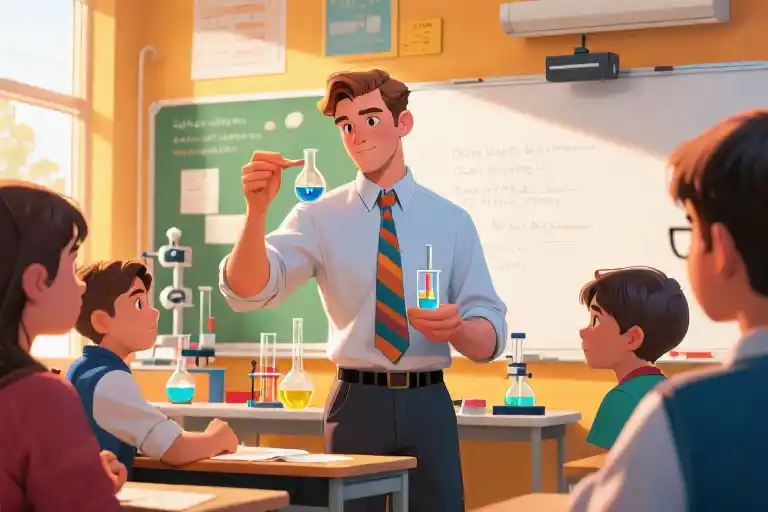The fluorescent lights hummed overhead as I adjusted my tie — the navy blue one that almost matched my shirt. Parent-Teacher Conference Night at Oakridge High always brought a special kind of chaos. I was arranging lab reports on my biology classroom desk when a woman in a burgundy sweater set peered in.
“Excuse me, young man,” she smiled, “could you tell me when Ms. Henderson will be back? I need to discuss my daughter’s grade.”
I swallowed a laugh. “Actually, I’m Mr. Henderson. Please, have a seat.” Her cheeks flushed three shades darker than her sweater as she stammered an apology. This wasn’t the first time. Wouldn’t be the last.
According to the National Center for Education Statistics, 28% of new teachers enter classrooms at 25 or younger. We’re the cohort carrying lesson plans in backpacks that still smell like college dorm rooms, the ones who get carded buying whiteboard markers at office supply stores. When your students are only three years younger than you, every “Mr.” or “Ms.” feels like playing dress-up in your parents’ clothes.
That night, three separate parents asked if I was a teacher’s aide. One father insisted on seeing “the actual adult in charge.” By my third year teaching, I’d developed a repertoire of responses:
- “The state of Pennsylvania believes I’m qualified — here’s my certification number if you’d like to verify.”
- “Fun fact: I’m older than the microscope technology we’re using this semester.”
- “Would it help if I started grading papers with a fake mustache?”
The staff lounge wasn’t much better. Colleagues twice my age called me “kiddo” and joked about needing permission slips for my coffee breaks. My principal once patted my shoulder and said, “Don’t worry, you’ll grow into your classroom.” Meanwhile, my sophomores were texting me memes about how we all looked the same age in our school IDs.
Here’s what they didn’t see:
- The 4am nights recutting dissection specimens because the shipment arrived spoiled
- Mastering the art of writing college recommendation letters before I’d finished paying my own student loans
- Developing a sixth sense for when a classroom’s energy was about to tip from engaged to chaotic
Youth in education isn’t a liability — it’s a secret weapon they don’t teach in credential programs. When my AP Biology students struggled with meiosis, I built a TikTok-style explainer video. While veteran teachers faxed attendance reports, I automated mine with Google Sheets. That time the district’s network crashed during finals week? My gaming laptop became the emergency testing hub.
So to every baby-faced educator hearing “You look too young to teach”: Your age isn’t undermining your authority — it’s upgrading what authority looks like. Now if you’ll excuse me, I need to go convince the cafeteria lady that yes, I am allowed in the teachers’ microwave.
The ‘Classmate’ Chronicles: When Your Students Are Almost Your Peers
At 21, most of my friends were worrying about frat parties and final exams. I was standing in front of 30 high school juniors, trying to explain mitosis while secretly hoping no one would ask why my voice cracked when saying ‘prophase.’ The age gap between me and my students? A whopping 3 years and 8 months. Some of my colleagues had teaching experience older than my driver’s license.
The Teacher’s Lounge Initiation
The faculty break room became my personal comedy club – except I was the punchline. ‘Morning, kiddo,’ the chemistry teacher would say, sliding the coffee pot toward me like it was my first sip ever. The math department chair once patted my shoulder and asked if I needed help finding my homeroom. My ‘professional wardrobe’ consisted of dress shirts from the boys’ section and a single striped tie that somehow always ended up stained with whiteboard marker.
Yet there was unexpected power in being the youngest. Students confided in me about college applications like I’d just survived them (I had). When Taylor Swift released new music, I didn’t need the cultural translation my older colleagues required. My lesson plans incorporated memes that were actually current, not painfully outdated like Mr. Henderson’s ‘YOLO’ reference from 2012.
The Dissection Day Turning Point
The real moment of truth came during our frog dissection lab. As 17-year-olds gagged at formaldehyde smells, I realized my shaky hands weren’t from inexperience – they mirrored every first-time biology teacher’s nerves, regardless of age. When Jessica whispered, ‘You’re handling this better than Mrs. Carlson did last year,’ it clicked: competence has no birth certificate.
Three key realizations got me through those early years:
- The Novice Advantage: My fresh perspective caught teaching gaps veterans had overlooked
- Energy as Currency: All-night grading sessions were easier when you’re fueled by youth and instant ramen
- Proximity Power: Speaking ‘Gen Z’ fluently built trust no amount of experience could replicate
By my third parent-teacher conference, when Mr. Thompson finally stopped asking when the ‘real teacher’ would arrive, I’d learned to lean into my youth rather than fight it. That mismatched tie became my signature look, the coffee jokes our department’s running gag. What began as insecurity transformed into my secret weapon – because in education, sometimes the newest models have the best features.
The Secret Weapons of Young Educators
Being the youngest person in the faculty room wasn’t just about surviving awkward introductions or perfecting my ‘serious teacher voice.’ Over time, I discovered three unexpected superpowers that turned my perceived weaknesses into professional strengths.
Tech Savvy: Rewriting the Rulebook
When I first introduced Google Classroom for lesson plan submissions, the department veteran’s eyebrow nearly disappeared into her hairline. ‘We’ve always used paper binders,’ she said, tapping her red pen like a judge’s gavel. Two months later, that same teacher was showing colleagues how to use our new collaborative grading system.
The turning point: During parent-teacher conferences, I could instantly pull up any student’s complete portfolio on my tablet while others fumbled with filing cabinets. Suddenly, being ‘the kid who understands computers’ became ‘the innovator streamlining our workflow.’
Energy Reserves: The 48-Hour Advantage
Fresh out of college, my ability to function on minimal sleep became legendary. When winter flu decimated our staff, I covered three biology labs back-to-back, graded 87 midterms overnight, and still had the mental clarity to explain cellular respiration to sleep-deprived juniors the next morning.
Pro tip: Young educators should channel this stamina strategically. I developed the 24-hour rule – using that extra energy to prep lessons two days in advance rather than pulling last-minute all-nighters. This created buffer time that impressed even the most skeptical colleagues.
Generational Radar: Cracking the Student Code
Speaking the same cultural language as my students gave me an invisible advantage. When a usually engaged sophomore started submitting blank assignments, I recognized the signs of TikTok burnout rather than assumed laziness. My solution? We negotiated ‘analog Wednesdays’ – no screens during class, which improved focus without feeling punitive.
The revelation: This generational insight works both ways. I became the unofficial translator between veteran teachers and Gen Z students, helping bridge communication gaps about everything from assignment formats to classroom participation norms.
From Suspicion to Strategy
The real transformation happened when I stopped apologizing for my age and started leveraging these advantages intentionally. That Google Classroom system? It became district-wide policy. My sleep-deprivation survival skills? Turned into a professional development workshop on teacher wellness. What began as defensive maneuvers became leadership opportunities.
Remember: Your fresh perspective isn’t a liability – it’s the upgrade your school didn’t know it needed. The key is packaging your natural abilities as solutions to existing problems rather than revolutionary changes.
“They called me ‘Baby Admin’ until I redesigned the faculty meeting agenda. Now they call me when the projector won’t connect.” – Journal entry, Year 3
The Conference Room Coup: A 27-Year-Old’s Management Debut
The first time I walked into an administrators’ budget meeting, the room fell into what I can only describe as ‘polite silence’ – the kind usually reserved for funerals and surprise tax audits. At 27, I wasn’t just the youngest person at the table; I was younger than some of the framed diplomas on the wall. The veteran principals exchanged glances that clearly said, “Who let the work-study kid in here?”
Breaking the Silence with Spreadsheets
When the district CFO started discussing the proposed science department cuts, I watched three gray-haired administrators nod sagely about ‘tough choices.’ That’s when I learned my first management survival skill: data is the great equalizer.
I’d spent nights compiling:
- Student performance metrics showing our biology scores improving 18% year-over-year
- Equipment replacement cycles proving our microscopes were older than most TikTok trends
- A color-coded map of STEM career opportunities within our county
Projecting those slides onto the screen, I saw postures change. The same principals who’d barely made eye contact were now squinting at my charts. One actually said, “Huh… hadn’t seen it that way” – which in administrator-speak translates to “I concede the point to the baby-faced newcomer.”
The ‘Baby Admin’ Nickname Flip
They called me ‘Baby Admin’ for months – at first with smirk, later with something resembling respect. The turning point came during our textbook adoption debate. When a veteran teacher insisted we stick with “tried-and-true” materials, I pulled up:
- Student feedback showing 72% found our current books “confusing and outdated”
- Side-by-side comparisons of chromosomal mutation diagrams (ours vs. 2023 editions)
- Cost analysis proving e-books would save $23k annually
The room got quiet again – but this time, it was the good kind of quiet. The kind where decisions get made. When the vote passed 7-1, our assistant superintendent muttered, “Guess we’re getting schooled by the kindergarten cop.” I chose to take that as a compliment.
Coffee Cup Credibility
Here’s what no leadership manual tells you: your mug matters. Those first weeks, I’d bring my ‘World’s Okayest Teacher’ travel cup to meetings until I noticed the unspoken rule – serious people drank from serious ceramics. Swapping to a plain white mug became my tiny act of professional camouflage.
Then something funny happened. After six months of delivering results (and remembering everyone’s preferred coffee order), they stopped caring about my age. The ‘Baby Admin’ jokes became affectionate rather than condescending. My youth became an asset – I was their ‘tech translator’ during the LMS transition, the ‘student whisperer’ during discipline appeals.
Management isn’t about age – it’s about:
- Listening more than you speak (especially to custodians and cafeteria staff)
- Backing opinions with evidence, not just experience
- Knowing when to fight for your ideas and when to let others shine
That budget meeting was three years ago. Last month, those same principals asked me to lead our district’s equity task force. The coffee still tastes burnt, but now they bring me the good creamer.
Rewriting the Definition of Authority in Education
Standing in the faculty lounge at 27, stirring my third cup of burnt-tasting coffee that morning, it hit me: the education system’s rulebook was being rewritten right under our noses. Not through policy changes or boardroom decisions, but through the quiet revolution of young educators like me who kept getting carded at teacher conferences.
The Shift from ‘Seasoned’ to ‘Hybrid’ Authority
For decades, education operated on a simple equation: gray hairs = credibility. My first-year teaching evaluations contained variations of “seems knowledgeable… for his age” like some bizarre academic backhanded compliment. But something fascinating happens when you’re forced to build authority without the crutch of seniority:
- Digital Native Advantage: While veteran teachers struggled with the LMS rollout, my students and I spoke the same technological language. My ability to troubleshoot a frozen SmartBoard during an observation became my first credibility currency.
- The Energy Dividend: When Mrs. Henderson from the English department joked about needing a nap after third period, I’d be heading to coach JV soccer with the same students I’d just taught. Physical stamina became professional capital.
- Cultural Translators: Being closer in age to students meant understanding TikTok trends weren’t just distractions—they were engagement opportunities. My lesson on cellular mitosis set to a viral dance trend had 92% recall on the unit test.
3 Survival Laws for Young Educators
After six years of being the human equivalent of an “Under New Management” sign, these became my non-negotiables:
1. The 24-Hour Rule
When challenged by senior staff, I learned to respond with: “That’s an interesting perspective. Let me research this and circle back tomorrow.” This simple tactic transformed perceived inexperience into thoughtful professionalism.
2. Data as Your Wingman
My breakthrough came when I replaced “I think” with “The metrics show” in faculty meetings. That spreadsheet comparing my students’ growth to district averages spoke louder than any years-of-experience argument.
3. Own the ‘Baby’ Label
When the science department christened me “The Embryo Administrator,” I printed it on a mug. Humor disarms critics, and confidence (even when faked) becomes contagious.
The Ripple Effects We’re Creating
What started as personal survival tactics are now reshaping education:
- Flipped Mentorship: I’m currently being “reverse mentored” by a 24-year-old new hire on Gen Z engagement strategies, while I coach her on parent communication. The one-way wisdom pipeline is obsolete.
- Credibility Remix: Our district’s recent PD survey showed 73% of staff now value “innovative approaches” over “years served” when identifying leaders—a 40% shift from five years ago.
- The Authenticity Advantage: My students don’t care that I can’t grow a proper beard. They remember that I’m the administrator who still remembers what cafeteria pizza tastes like and why third-period chemistry feels endless.
The coffee’s still terrible in the admin office, but the view from here? It’s spectacular. They told us we were too young to lead. Turns out, we were just the new edition they didn’t know they needed.
Redefining What It Means to Be Young in Education
They told me I was too young. What they didn’t understand was that my youth wasn’t a bug in the system—it was the latest feature update.
The Unexpected Superpower
Looking back at my journey from being mistaken for a student to earning my place at the administrators’ table, I’ve realized something fundamental: young educators don’t need to fit into old molds to be effective. Our fresh perspective is exactly what education systems need to evolve. That energy that made me pull all-nighters grading papers? It’s the same drive that helps me implement new teaching technologies. That slight age gap with students? It became my secret weapon for understanding Gen Z learning patterns.
Your Youth Is Your Competitive Edge
Here’s what no one tells young teachers entering traditional systems:
- Technology fluency isn’t just about using apps—it’s about reshaping communication flows (like how I revolutionized our lesson plan submissions with collaborative docs)
- Near-peer status creates trust bridges with students that decades of experience can’t replicate
- Adaptability means you can toggle between being the tech support guru and the empathetic mentor before your first coffee break
Join the Movement
This isn’t just my story—it’s happening in schools across the country. That’s why I’m starting the #YoungButProfessional conversation. Share your moments when:
- Your “inexperience” led to an innovative solution
- Students connected with you in ways they couldn’t with older staff
- You turned a skeptical colleague into an ally
Your Age Advantage Toolkit
I’ve created a free Age Advantage Conversion Checklist with:
- Scripts for handling “Aren’t you too young…” comments
- Quick wins to establish credibility in your first month
- How to leverage your generational perspective in staff meetings
Remember: In a field that shapes the future, being the “new model” educator isn’t a weakness—it’s your strategic advantage. They’ll stop calling you “Baby Admin” when they start calling you “the change-maker.”





